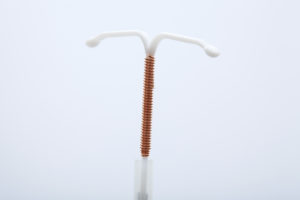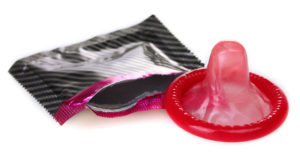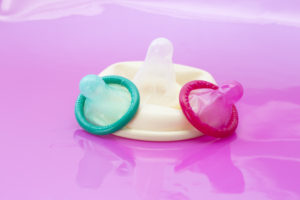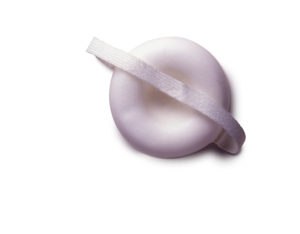Please note that this post contains affiliate links and any sales made through such links will reward me a small commission.
Let’s be honest. The side effects of hormonal birth control are annoying. The mood swings, hair loss, or weight gain is enough to send your pills packin’. If you’re thinking of ditching your birth control but are not ready to jump into parenthood quite yet, keep reading.
You might be surprised to find out that there are quite a few hormone-free birth control choices available. But here’s the thing, some are more effective in preventing pregnancy than others. Let me give you a quick rundown of your options and what you should expect with typical use.
1. Copper IUD (Paragard)
The copper IUD (intrauterine device) is birth control for your uterus. This small T-shaped plastic device is wrapped in copper wire and works by thickening your cervical mucus making it harder for sperm to meet your egg. If you’re worried about the effects of copper, you shouldn’t be. Studies show that the IUD only releases a tiny amount of copper- not enough to cause you harm. The good news is that the copper IUD is more than 99.9% effective at preventing pregnancy and can last for up to 12 years but you certainly don’t have to keep it in that long. Whenever you’re ready to grow your baby-bump, you’ll need a quick trip to your doctor to get it removed. Your fertility will go back to normal right away. So let’s talk about some of the side effects you might experience- irregular periods, heavier or longer periods, or more cramping which may or may not get better over time (helpful I know). The copper IUD itself does not protect against sexually transmitted infections (STI) so grab a condom before gettin’ busy.
2. Male Condoms (Male Condom)

Here’s the deal. The external or male condom is a thin sheath usually made up of latex, polyurethane, or lambskin. It comes in a variety of widths, thickness, and colors. They are cheap and readily available (you can pick some up at your local grocery store, pharmacy, heck even at the gas station). If used perfectly condoms are 98% effective in preventing pregnancy but 82% effective with typical use (you know when using it during real-life situations).
Use a new condom with every different sex act and be sure to check the expiration date (yes, it can expire like your milk). Only use water or silicone-based lubes with your rub, so ditch the Vaseline boo! Condoms also help protect you against sexually transmitted diseases like gonorrhea, chlamydia, and HIV.
3. Female Condom (Internal Condom)
Honestly, most women have never actually seen a female condom. So let me give you a quick intro:
Similar to the external condom, the female condom is a thin lubricated sheath but it’s worn inside your vagina during sex. This condom is made of nitrile, a type of synthetic rubber that is latex-free. With typical use, the internal condom is 79% effective against pregnancy. Like anything new, it will take time to get used to so be patient.
4. Diaphragm or cervical cap
These barrier methods are placed inside your vagina to cover your cervix and block sperm from meeting your egg. A diaphragm is shaped like a shallow cup and is made of latex or silicone while the silicone-based cervical cap looks more like a miniature sailor’s hat. Use a spermicide with both the diaphragm and cervical cap to increase effectiveness. One of the drawbacks about these methods is that they are not a one-size fit all. Your doctor will have to fit you for one since they come in a range of sizes. Each year about 12 percent of women become pregnant while using the diaphragm while almost 29% of women become pregnant using the cervical cap.
5. Spermicide
This kind of birth control has many chemicals including nonoxynol-9 which slows sperm down or stops them from moving altogether. Spermicide comes in many forms including cream, gel, foam, and film. I’m most familiar with is VCF spermicide film. Basically, it looks like a larger version of a Listerine Strip but it doesn’t freshen your breath-it blocks sperm. For best use make sure you insert it into your vagina at least 15 minutes before sexy time. Take the small square, fold it a couple of times then insert into your vagina as close to your cervix as possible. Make sure your hands are clean and dry before starting. The film dissolves in a matter of minutes and turns into a gel-like film (don’t worry, it’s not runny or messy, you probably won’t even know it’s there).
To double your protection efforts make sure you also use a condom or diaphragm. Honestly, spermicides are probably not the best option if you’re serious about avoiding pregnancy since 28 out of 100 couples end up getting pregnant using this method. Spermicides don’t protect against sexually transmitted infection so use a condom.
6. Cervical Sponge
So this isn’t your average kitchen sponge. The cervical sponge is small, round, and made from a flexible plastic. The sponge prevents pregnancy by blocking the entrance to your uterus so sperm can’t swim up there. To use place the sponge deep inside your vagina near your cervix before sex and don’t worry about it getting lost- it has a small fabric loop to help you remove it. Like a cervical cap or diaphragm, use spermicide with the sponge for maximum protection. By the way, sponges are one-time use only so no reusing boo!
Buy your sponge over-the-counter, no prescription or fitting needed. If you’re sensitive to polyurethane or prone to UTI’s, this probably not the best choice for you. The cervical sponge is 14% effective in preventing pregnancy in women who have never had a baby and 27% effective in women who have had children. The sponge doesn’t protect against STI so use that condom.
 7. Fertility Awareness Method
7. Fertility Awareness Method
If you like graphs and charts, the fertility-based awareness method (FAM) may be for you. I’ve actually used this method myself when trying to get pregnant (read about it here). Simply put, FAM helps you pinpoint ovulation or when your body releases an egg to avoid baby-making. It also helps you track your fertility signs
There are a couple of different ways of doing this:
- The temperature method: take your temperature every morning before getting out of bed. For the first half of your menstrual cycle, your body temperature will be in a lower range. Eventually, you should see your temperature rise during the second half of your cycle. The upward temperature swing is when ovulation happens.
- The cervical mucus method: check your vaginal discharge every day. Closer to ovulation you will notice more clear and wet discharge which is you’re most fertile period. Avoid sex when you see this to lessen your chances of pregnancy.
- The calendar method: You can predict your most fertile days by tracking the length of your period over several months (at least 6 months). Record the first day of your period then record the first day of your next period. Count the total numbers of days in between each cycle. Warning- if your periods are shorter than 27 days or are irregular this method won’t work for you. To predict when it’s safe to have sex- find the shortest cycle in your record and subtract 18 from the total number of days in that cycle. For example, if your shortest cycle is 26 days long, subtract 18 from 26 which equals 8. The first day of your menstrual cycle is the first day you bleed and the 8th day of your cycle is your first fertile day.
Determining your Fertile Days
To determine the length of your longest cycle and subtract 11 from the total number of days of your longest cycle. For example, if your longest cycle is 35 days, subtract 11 from 35 which equals 24. In this example, the first day of your cycle is the first day you bleed and the 24th day of your cycle is your last fertile day. To avoid pregnancy don’t have sex during your fertile days- so using the previous examples, no sex from day 8 through day 24. Keep recording your cycle lengths every month to make sure that you are accurately recording your fertile days.
FYI– certain factors like illness, travel or medicine can affect the exact timing of ovulation so adding another birth control method like a condom is strongly encouraged. Truthfully, fertility tracking does take some getting used to and requires a certain level of commitment. On average 12-24 % of women will get pregnant using the FAM method so if it’s too soon for breast pumping and diaper changing, think about adding another birth control method.
Hormone-Free Birth Control Options
If you’re ready to ditch the hormones but are not quite ready for parenthood, give a hormone-free birth control a try. Although some are less effective at preventing pregnancy when compared to hormonal birth control, they can provide affordable and safe alternatives for an active and healthy sex life.
Have you ever tried a hormone-free birth control method? Write your comments below.

Great blog! Do you have any recommendations for aspiring writers? I’m planning to start my own website soon but I’m a little lost on everything. Would you advise starting with a free platform like WordPress or go for a paid option? There are so many options out there that I’m completely confused .. Any ideas? Bless you!
Hello,
It depends. I got the paid version since it provides more platform features but if you want to get your feet wet the free version will work just fine.
Love the!! So much information and so much to think about. I think I’ve tried 85% of them. LOL
Girl,
You should have written this article.